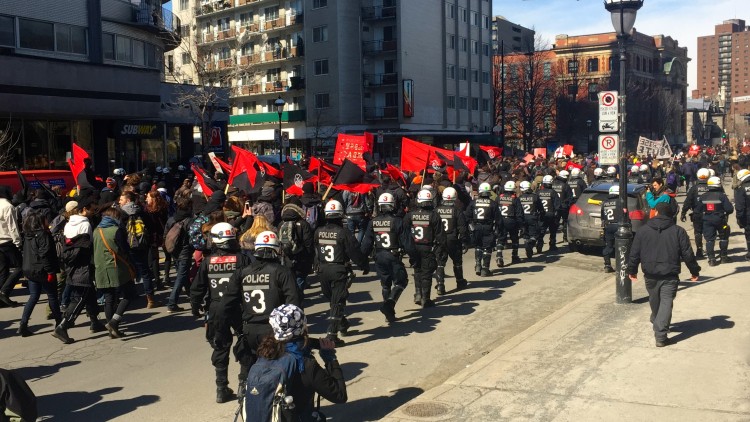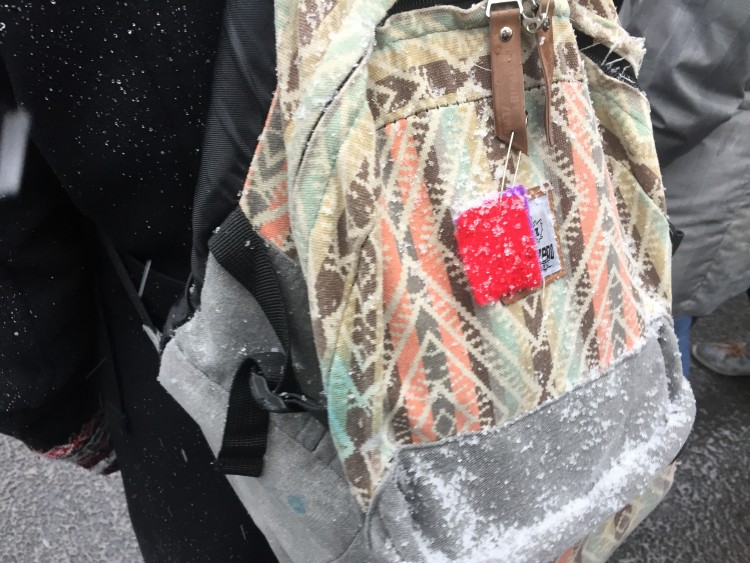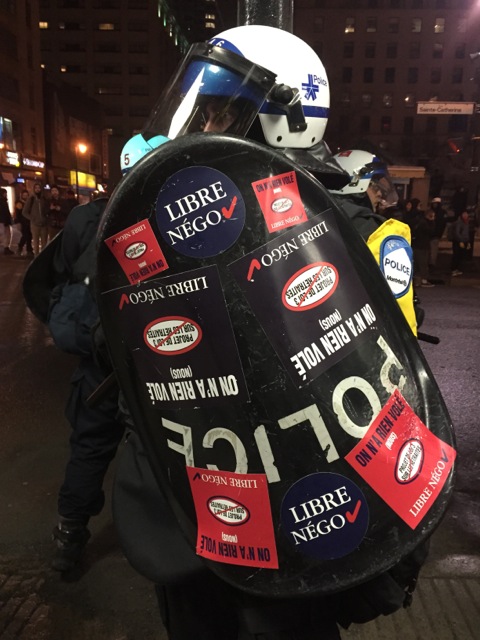Vers un Automne Érable?1
Whenever threatened, the first thing power restricts is the ability to linger or assemble in the street.
—Henri Lefebvre2
In September of 2014, I arrived in Montréal to study the students’ strike that had erupted throughout the province of Québec three years earlier. I was particularly interested in learning more about the evolution of the movement itself and the networks it had forged with related movements: the Chilean student protests, Occupy Wall Street, and 15M.
Upon arrival, however, I was immediately struck by the rather strange sight of police dressed in camouflage pants of all different shades and colors—pink, red, orange, green, yellow, brown, black, and blue. While the appearance of these fatigues could be mistaken as one more (albeit colorful) step down the path of a militarized police force, it was actually a sign of dissent.3 Similar to other segments of Québec society, the police were negatively affected by the austerity measures adopted by Philippe Couillard’s Liberal government.4 Alongside the protest tactics developed by employees of the police, the topic of austerity seemed ever present during the early days of my research: at a downtown protest for daycare workers, for instance, a panel discussion on “austerity and education”—discussed on radio and television and across local and national newspapers. These public protests and discussions alerted me to the growing opposition to the government’s imposition of austerity measures.
Although I had initially come to Montréal to study the cross-border solidarities that had formed around the 2012 students’ strike, it was literally impossible to ignore the anti-austerity protests that were erupting across the city or to remain a neutral observer. My participation in the fall/spring protests allowed me to make connections with a broad segment of the population affected by the Couillard government’s austerity measures, and to intimately understand how the widespread protests were being suppressed. Here I portray austerity as the backdrop to the 2015 spring students’ strike, describe a tactical division that emerged, and highlight the repressive strategies of the government through the lens of les manifs de nuit (night protests).
Tactical divisions
The tuition fee increase of 2012 was designed to divide public opinion on the question of austerity and to generate favorable terrain for its widespread implementation at a later date. While the strength of the Printemps Érable (Maple Spring) delayed the advancement of this neoliberal “cultural revolution” by a couple of years, by the time of my arrival in 2014, austerity was back on the table (Desjardins 2010: B1, B4; Dutrisac 2014: A1, A10; Marotte 2010: B6). This time the scope had widened and cuts were being extended to health care, education, community groups, and other social services (Nguyen 2015).
To combat the austerity measures, some Quebecers are organizing across class and social boundaries (Sadikov and Zhi 2015: 4). La Coalition opposée à la tarification et à la privatisation des services publics, bringing together grassroots organizations, unions, community groups, feminists, and students, released a report of fiscal solutions that challenge the need for austerity measures (Dix milliards de solutions 2015). They were among the many community groups to rally alongside public-sector unions, students, and citizens at a pair of large demonstrations in the fall of 2014 (Nadeau 2015a: A1; 2015b: A5). It was within this political climate that I heard about le comité Printemps 2015 (P15). Established at l’Université du Québec à Montréal (UQAM), P15 was an informal group of (mostly student) activists (Richard 2015: 7). Consisting largely of l’Association pour une solidarité étudiante (ASSÉ) members, P15 organized independently of ASSÉ but engaged with its structure to mobilize its membership base.5
During a January assembly of P15, conflicting thoughts emerged over the timing of the students’ strike. One participant thought the spring too soon, noting how public-sector unions (in the midst of contract negotiations) cannot legally strike until the autumn. To build an effective coalition between students and workers, he urged, it made sense to wait. While P15 continued to promote the spring regardless, ASSÉ encouraged limited springtime involvement and a greater mobilization in the fall. Despite the differing views, many students voted for a renewable strike throughout March and April.6 When (partway through the protests) the ASSÉ executive recommended a strategic retreat until the autumn, both their membership base and P15 rebuked them in defiance (Cook 2015; Paré and Fortier 2015: A1).7
Principally a Montréal-based Francophone strike, UQAM played an important role in the protests while l’Université de Montréal and a handful of Collèges d’enseignement général et professionnel (CEGEPs) contributed as well.8 Building upon the French–English solidarities that formed in 2012, a significant Anglophone contingent participated—particularly from Concordia University. A diversity of tactics was employed, from soft and hard picket lines to direct-action strategies (manifs-actions) and public demonstrations. The strike culminated on April 2, when close to 135,000 students were on strike, and 50,000 to 70,000 students, workers, community groups, and everyday citizens converged upon Montréal for a massive downtown march (Orfali 2015a: A1, A10). Despite its intense and spirited nature, the protests soon dwindled as student associations voted to discontinue their involvement. Notwithstanding a resurgence on May Day alongside unions and community groups, the movement has gone into retreat (Paré and Rettino-Parazelli 2015: A3). The ASSÉ Congress has since adopted a campaign for a general unlimited strike when classes resume in September.
There are two ways of looking at the spring protests. On the one hand, it may seem as though le comité Printemps mistimed the entire affair, rushing to mobilize before all elements of the growing solidarity across class and social boundaries were ready or able to strike. Some people worry that this “premature” mobilization will lead to “revolutionary fatigue,” compromising the chance to organize alongside public-sector unions in the fall.9 On the other hand, the spring strike can be considered a bellwether of the new political climate—a movement that materialized out of the growing frustration toward widespread austerity measures.10 The spring protests were an opening salvo, a mobilization that challenged austerity measures and provided young activists with valuable learning experience. Whatever the case may be, the legacy of the spring will be determined in the fall, as time will tell whether the strike helped or hindered the building of an autumn coalition.
Les manifs de nuit and repressive state tactics
Similar to 2012, les manifs de nuit would start after dusk at Place Émilie-Gamelin—a city square located across the street from UQAM. As people assembled and the time of the march grew near, so did the feeling of excitement as the combination of talking, laughing, drumming, and chanting made for a festive atmosphere. People held flags, others had signs, and many wore the iconic red square on their backpacks and lapels. Popularized in 2012, le carré rouge symbolizes the notion of being squarely in the red, or squarely in debt. One soon felt immersed in a sea of individuals—an expanse sometimes parted by a column of police who insisted on walking through the dense assemblage. Students’ disapproval of this tactic would manifest by way of chant: “pas de police dans nos manifs” (no police in our protests). On several occasions a handful of students formed a conga line behind the rearmost officer, using ridicule and jest.
After enough people had gathered at the starting point, it was possible to take the streets and the march would begin. Police presence was always heavy, and lines of police (clad in dark riot gear) flanked protesters as they proceeded down the street. The use of force was not uncommon as the police used shields, batons, bicycles, tear gas, and flash grenades to disrupt the group’s ability to assemble and move. At other times, pepper spray, rubber bullets, mounted police, and K-9 units were employed. Kettling was an oft-used technique, as small to large groups of demonstrators were arrested and detained for an extended period of time, and then issued heavy fines upon their release.
One memorable night manif came in late March. Large white snowflakes descended gently from the sky, and the crowd was a few thousand strong. Beginning from the usual starting point, we meandered toward the downtown core. Once there, and already having been rebuffed from marching down the touristy St. Catherine Street, the group circled the block for a second attempt. Rebuffed again, this time the riot police rushed in from two sides—banging their batons on the backs of their riot shields while doing so.
As everyone started to retreat, a trickle of sparks flew through the air, and a projectile landed to my right: BOOM! The thunderous sound of a flash grenade was followed by another seconds later. A line of police advanced, yelling at everyone to fall back. I turned the corner, and the loud dint of two more flash grenades echoed in the distance. As the column of police spread across the intersection of de Maisonneuve and Aylmer, streetlight accentuated the protest stickers on their riot shields, red and blue squares that exclaimed “On n’a rien volé [nous]” (we have stolen nothing) and “Libre Négo” (free negotiations): slogans protesting the same austerity measures that students were protesting that very night.
I headed back toward the square and was met by a group of demonstrators who had reassembled and were marching up the street. Defiant, they began to shout in unison: “on reste, on reste, on reste groupé” (we remain, we remain, we remain together). The group was quickly repulsed by two more flash grenades and another baton-rattling charge from the riot squad. Tear gas ensued and the once large demonstration was successfully broken up into a handful of smaller protests.
By ten o’clock I started to walk home and ended up on the large sidewalk across from Phillips Square. Accompanied by a handful of students and bystanders, I watched the police remove the few remaining protestors from the area. An enigmatic older man was talking loudly and held a sign: “Droit et liberté de manifesté contre l’austerité: Démocratie internationale” (The right and freedom to demonstrate against austerity: International democracy.) Before I could understand what was happening, we were kettled by police, detained for more than an hour, and ticketed $640 for contravening bylaw P-6—failure to conform immediately with the order of a “peace officer” to leave an illegal assembly. In total, eighty-one people were kettled and ticketed throughout various locations that night. This was my second ticket in as many weeks, and unless otherwise contested, I now owed the City of Montréal $1,144.11
In addition to the police, university administrations and the judiciary played a repressive role in the strike. At UQAM, administrators proceeded to expel nine student leaders for actions allegedly committed during and after the 2012 strike (Fortier 2015: A1). The judiciary granted injunctions that forced classes to be taught in defiance of strike mandates, and took strict measures with many students who were arrested (Ruiz 2015: A3). In response to the expulsions, court injunctions and arrest of twenty-one activists at UQAM, more than a hundred students occupied the lower pavilion of that university’s main building in April. When the rector asked police to intervene, a confrontation ensued and twenty-two people were arrested (Orfali 2015b: A1, A8).
The repressive measures employed throughout the spring are not new. A report released by la Ligues des droits et libertés (LDL) details 5,895 arrests at 185 demonstrations throughout Québec over the past four years (Chicoine-MacKenzie et al. 2015). This suggests that the intensification of austerity measures has gone hand in hand with an increase in the police repression of political rights. Given the police efforts to restrict students’ ability to linger or assemble in the street, it’s reasonable to suggest that the state feels threatened by their capacity to organize and strike. This underscores students’ political strength in Québec, their understanding of neoliberalism, and their willingness to organize against it. If students can redouble their efforts alongside public-sector workers and community groups in the fall, and should this coalition overcome the mounting repression of the state, then a serious challenge to the neoliberalization of Québec society could be made. While the future remains unclear, given the circumstances, it seems appropriate to at least ask the question: can Printemps 2015 turn into an Automne Érable?
David Cooney is a doctoral candidate in the Department of Anthropology at Memorial University of Newfoundland. As part of his PhD work, he seeks to analyze how the financialization of capital (and debt relations that follow in its wake) have underwritten a series of popular protest movements that both characterize and identify the formation of new class relationships across social and geographic boundaries. His research is supported by the Social Sciences and Humanities Research Council of Canada.
All photos in this post are credited to the author.
Notes
1. Toward a Maple Autumn?
2. “L’interdiction de séjourner et de se rassembler dans la rue est la première que prend le pouvoir, en cas de menace” (Lefebvre [1970] 2003: 20).
3. Although many police have chosen to don camo pants, the symbolic protest in fact extends to all types of non-uniformed trousers, including jeans and pajamas (Lamoureux 2015).
4. They, along with firefighters and municipal workers, specifically objected to pension reforms that would negatively impact their retirement savings.
5. As one sociology professor from UQAM recently quipped, this may be the first time that a political movement (le comité Printemps) has tried to capture the machinery of ASSÉ, and this has raised tensions between an Occupy-style affinity method of organizing (P15) and democratic assembly model (ASSÉ). ASSÉ is Québec’s most militant student union, and it played an important role in the 2012 strike.
6. The strike is described by French speakers as “une grève générale reconductible.”
7. Published on the Printemps 2015 website, P15 expressed sharp disapproval in a commentary entitled “L’ASSÉ ne fait pas le printemps” (The ASSÉ won’t bring the spring). The ASSÉ membership voted to impeach the executive, despite its earlier resignation.
8. CEGEPs are publicly funded post-secondary institutions that act as an intermediary between high school and university, and offer both academic and technical studies. While Montréal was the center of the strike, important student organizing also occurred elsewhere, including Québec City, Chicoutimi, and Sherbrooke.
9. This sentiment was described to me by a friend and student activist who took part in the spring strike.
10. By focusing on austerity and hydrocarbon issues, this is the first students’ strike in Québec since the 1960s that is not primarily about student issues.
11. The first ticket was issued under Section 500.1 of the Highway Safety Code, and cost $504.
References
Chicoine-MacKenzie, Laurent , Nicole Filion, Véronique Fortin, Lynda Khelil, Lucie Lemonde, Ann Dominique Morin, and Jacinthe Poisson. 2015. Manifestations et répressions: Points saillants du bilan sur le droit de manifester au Québec. Montréal: Ligue des droits et libertés (LDL).
Cook, Jonathan. ASSÉ Congress votes to have executives impeached, The Link, 8 April.
Desjardins, François. 2010. Une “révolution culturelle” selon Raymond Bachand, Le Devoir, 23 February.
Dix milliards de Solutions: Nous avons les moyens de faire autrement! 2015. Montréal: Coalition opposée à la tarification et à la privatisation des services publics.
Dutrisac, Robert. 2014. Une impasse budgétaire de 3,7 milliards: Philippe Couillard impose des compression immédiates pour sortir le Québec de l’endettement, Le Devoir, 25 April.
Fortier, Marco. 2015. L’UQAM expulse 9 étudiants “militants,” Le Devoir, 24 March.
Lamoureux, Julien. 2015. Les pantalons des policiers de Montréal retiennent l’attention sur Reddit, Le Huffington Post, 12 June.
Lefebvre, Henri . [1970] 2003. La révolution urbaine [The urban revolution]. Trans. Robert Bononno. Minneapolis: University of Minnesota Press.
Marotte, Bertrand. 2010. Aging workers prompts “cultural revolution” call: Quebec finance minister says major rethink needed in way province taxes, provides services, Globe and Mail, 23 February.
Nadeau, Jean-François. 2015a. Sous le signe de la colère et de l’épouvante, Le Devoir, 1 November.
Nadeau, Jean-François. 2015b. Cri populaire contre l’austérité, Le Devoir, 1 December.
Nguyen, Minh. 2015. Compilation des conséquences des mesures d’austérité 2014–2015. Montréal: Institut de recherche et d’informations socio-économiques (IRIS).
Orfali, Philippe. 2015a. Les étudiants n’étaient pas seuls, Le Devoir, 3 April.
Orfali, Philippe. 2015b. Dérapage majeur à l’UQAM, Le Devoir, 9 April.
Paré, Isabelle, and Marco Fortier. 2015. Le movement étudiant bat de l’aile: L’ASSÉ appelle à la revision de sa stratégie et propose le report de la grève à l’automne, Le Devoir, 1 April 1.
Paré, Isabelle, and Karl Rettino-Parazelli. 2015. Des action aux quatre coin du Québec contre les politiques d’austérité, Le Devoir, 2 May.
Richard, Léo. Printemps 2015 contre l’austerité, Le Délit, 21 October.
Sadikov, Igor, and Peter Zhi. 2015. Unions, communities unite against austerity, McGill Daily, 19 January.
Ruiz, Pedro. 2015. Hamza Babou remis en liberté devant ses pairs, Le Devoir, 1 May.
Cite as: Cooney, David. 2015. “The Montréal student protests: Vers un Automne Érable?” FocaalBlog, 13 July, www.focaalblog.com/2015/07/13/david-cooney-the-montreal-student-protests.
Discover more from FocaalBlog
Subscribe to get the latest posts sent to your email.


